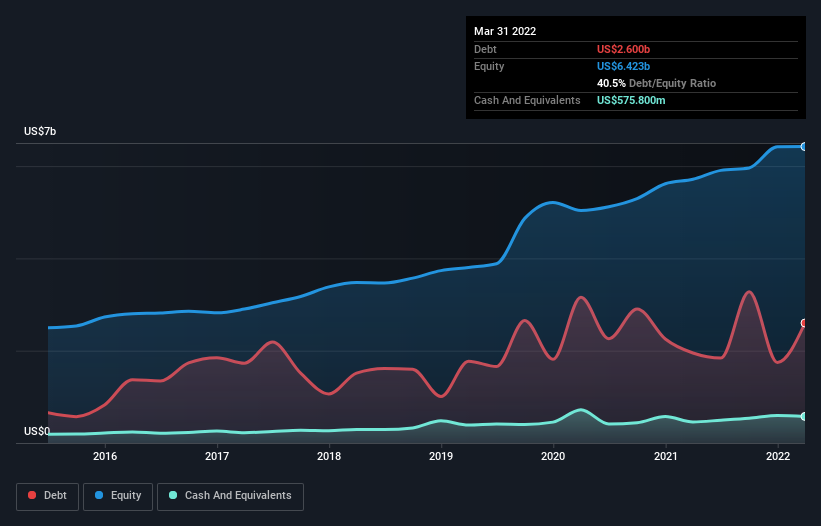- United States
- /
- Real Estate
- /
- NYSE:JLL
Here's Why Jones Lang LaSalle (NYSE:JLL) Can Manage Its Debt Responsibly

David Iben put it well when he said, 'Volatility is not a risk we care about. What we care about is avoiding the permanent loss of capital.' When we think about how risky a company is, we always like to look at its use of debt, since debt overload can lead to ruin. We can see that Jones Lang LaSalle Incorporated (NYSE:JLL) does use debt in its business. But the more important question is: how much risk is that debt creating?
When Is Debt A Problem?
Debt assists a business until the business has trouble paying it off, either with new capital or with free cash flow. Ultimately, if the company can't fulfill its legal obligations to repay debt, shareholders could walk away with nothing. However, a more usual (but still expensive) situation is where a company must dilute shareholders at a cheap share price simply to get debt under control. Having said that, the most common situation is where a company manages its debt reasonably well - and to its own advantage. The first step when considering a company's debt levels is to consider its cash and debt together.
View our latest analysis for Jones Lang LaSalle
How Much Debt Does Jones Lang LaSalle Carry?
You can click the graphic below for the historical numbers, but it shows that as of March 2022 Jones Lang LaSalle had US$2.60b of debt, an increase on US$1.95b, over one year. However, it does have US$575.8m in cash offsetting this, leading to net debt of about US$2.02b.

How Strong Is Jones Lang LaSalle's Balance Sheet?
We can see from the most recent balance sheet that Jones Lang LaSalle had liabilities of US$5.40b falling due within a year, and liabilities of US$3.57b due beyond that. On the other hand, it had cash of US$575.8m and US$4.32b worth of receivables due within a year. So its liabilities outweigh the sum of its cash and (near-term) receivables by US$4.07b.
Jones Lang LaSalle has a market capitalization of US$9.37b, so it could very likely raise cash to ameliorate its balance sheet, if the need arose. However, it is still worthwhile taking a close look at its ability to pay off debt.
We measure a company's debt load relative to its earnings power by looking at its net debt divided by its earnings before interest, tax, depreciation, and amortization (EBITDA) and by calculating how easily its earnings before interest and tax (EBIT) cover its interest expense (interest cover). The advantage of this approach is that we take into account both the absolute quantum of debt (with net debt to EBITDA) and the actual interest expenses associated with that debt (with its interest cover ratio).
Jones Lang LaSalle's net debt is only 1.3 times its EBITDA. And its EBIT easily covers its interest expense, being 30.6 times the size. So we're pretty relaxed about its super-conservative use of debt. On top of that, Jones Lang LaSalle grew its EBIT by 70% over the last twelve months, and that growth will make it easier to handle its debt. The balance sheet is clearly the area to focus on when you are analysing debt. But it is future earnings, more than anything, that will determine Jones Lang LaSalle's ability to maintain a healthy balance sheet going forward. So if you want to see what the professionals think, you might find this free report on analyst profit forecasts to be interesting.
But our final consideration is also important, because a company cannot pay debt with paper profits; it needs cold hard cash. So we always check how much of that EBIT is translated into free cash flow. Over the most recent three years, Jones Lang LaSalle recorded free cash flow worth 66% of its EBIT, which is around normal, given free cash flow excludes interest and tax. This cold hard cash means it can reduce its debt when it wants to.
Our View
The good news is that Jones Lang LaSalle's demonstrated ability to cover its interest expense with its EBIT delights us like a fluffy puppy does a toddler. But truth be told we feel its level of total liabilities does undermine this impression a bit. Zooming out, Jones Lang LaSalle seems to use debt quite reasonably; and that gets the nod from us. While debt does bring risk, when used wisely it can also bring a higher return on equity. There's no doubt that we learn most about debt from the balance sheet. However, not all investment risk resides within the balance sheet - far from it. For example, we've discovered 1 warning sign for Jones Lang LaSalle that you should be aware of before investing here.
If you're interested in investing in businesses that can grow profits without the burden of debt, then check out this free list of growing businesses that have net cash on the balance sheet.
New: Manage All Your Stock Portfolios in One Place
We've created the ultimate portfolio companion for stock investors, and it's free.
• Connect an unlimited number of Portfolios and see your total in one currency
• Be alerted to new Warning Signs or Risks via email or mobile
• Track the Fair Value of your stocks
Have feedback on this article? Concerned about the content? Get in touch with us directly. Alternatively, email editorial-team (at) simplywallst.com.
This article by Simply Wall St is general in nature. We provide commentary based on historical data and analyst forecasts only using an unbiased methodology and our articles are not intended to be financial advice. It does not constitute a recommendation to buy or sell any stock, and does not take account of your objectives, or your financial situation. We aim to bring you long-term focused analysis driven by fundamental data. Note that our analysis may not factor in the latest price-sensitive company announcements or qualitative material. Simply Wall St has no position in any stocks mentioned.
About NYSE:JLL
Jones Lang LaSalle
Operates as a commercial real estate and investment management company.
Very undervalued with flawless balance sheet.
Similar Companies
Market Insights
Community Narratives



